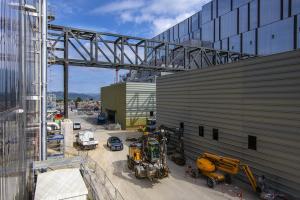A bridge over the busy boulevard
Of the three, the cryobridge—whose main structure was finalized during the summer—is the most complex. Beginning perpendicular to the cryoplant, it runs for some 70 metres before abruptly turning left at a 90-degree angle to run parallel to the Assembly Hall for another 60 metres in order to reach the Tokamak Complex.
The 440-tonne cryobridge is supported by two sets of 4.5-metre-tall pillars, attached to the concrete piles by articulated pinned supports. Each concrete pile is anchored deep into the bedrock by way of 12 steel studs, measuring 12.7 metres long and 25 centimetres in diameter. Isostatic attachments, located on the building that stands between the cryoplant and the Assembly Hall, provide additional support while allowing some movement.
As the cryolines are strongly insulated inside their vacuum piping, the cryobridge will be simply roofed and clad in the trademark ITER "bar-code" finish.
Spanning the construction platform's main boulevard, more than 10 metres above the constant traffic of trucks and construction machinery, the three bridges will add an urban, almost futuristic touch to the already spectacular landscape of the ITER installation.




